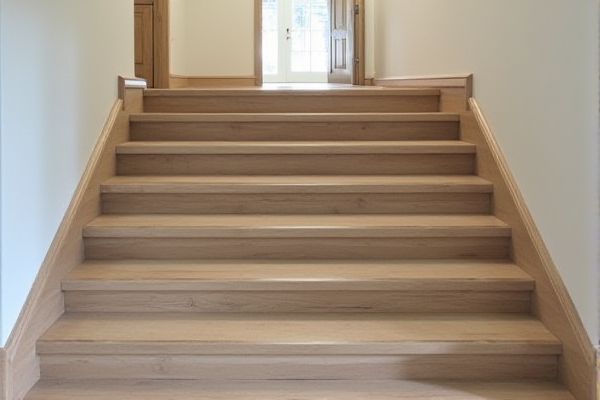
Slip-resistant stairs provide enhanced safety by offering better traction compared to standard finishes, reducing the risk of slips and falls in both residential and commercial settings. Discover how choosing the right stair finish can improve your safety and comfort throughout this article.
Table of Comparison
| Feature | Slip-Resistant Stairs | Standard Finish Stairs |
|---|---|---|
| Safety | High slip resistance, reduces falls and accidents | Low slip resistance, higher risk of slips |
| Material | Textured surfaces, anti-slip coatings, rubber treads | Smooth wood, metal, concrete, or tile finishes |
| Maintenance | Requires regular cleaning to maintain grip | Easy to clean but may become slippery when wet |
| Durability | Resistant to wear, designed for heavy foot traffic | Varies by material; may show wear quickly |
| Cost | Typically higher due to specialized materials | Generally lower upfront cost |
| Applications | Commercial buildings, public access, safety-critical areas | Residential spaces, non-slip critical areas |
Introduction to Stair Safety
Slip-resistant stairs significantly enhance safety by reducing the risk of falls, especially in wet or high-traffic environments. Unlike standard finishes, slip-resistant surfaces feature specialized textures or coatings designed to increase traction and prevent slipping. In workplaces and public spaces, incorporating slip-resistant materials is a crucial measure to meet safety regulations and protect users from injuries.
Understanding Slip-Resistant Stairs
Slip-resistant stairs feature textured surfaces or coatings designed to enhance grip and reduce the risk of slips and falls, especially in wet or oily conditions. Standard finish stairs typically have smooth surfaces that can become hazardous when wet or worn, lacking the additional traction provided by slip-resistant options. Ensuring your stairs are slip-resistant improves safety by providing better footing and increasing overall stability for users.
Defining Standard Finish Stairs
Standard finish stairs typically feature smooth surfaces made from wood, metal, or concrete, lacking specialized slip-resistant treatments. These stairs prioritize aesthetic appeal and ease of cleaning but may pose higher risks of slipping, especially in wet or high-traffic environments. In contrast, slip-resistant stairs incorporate textured surfaces, non-slip coatings, or abrasive materials to enhance traction and safety.
Importance of Traction in Stairways
Slip-resistant stairs provide crucial traction that significantly reduces the risk of falls and injuries compared to standard finishes. Proper traction ensures stability, especially in wet or oily conditions, enhancing overall safety in residential and commercial environments. You benefit from increased confidence and security when navigating stairways equipped with slip-resistant surfaces.
Material Differences: Slip-Resistant vs Standard
Slip-resistant stairs use materials like rubber, textured vinyl, or specially coated metal to enhance grip and reduce the risk of slipping, whereas standard stairs typically feature smooth surfaces such as polished wood or plain concrete. The textured or abrasive finish in slip-resistant stairs provides better traction under wet or oily conditions, ensuring safer footing for Your daily use. Material differences directly affect durability and maintenance, with slip-resistant options often designed to withstand harsher environments without compromising safety.
Durability and Maintenance Comparison
Slip-resistant stairs feature enhanced durability due to specialized coatings or textured surfaces that resist wear and maintain effective traction over time. Standard finish stairs may show wear more quickly, requiring frequent maintenance such as refinishing or cleaning to preserve safety and appearance. Choosing slip-resistant stairs reduces the need for intensive upkeep, ensuring your stair safety features remain intact with minimal effort.
Aesthetic Considerations
Slip-resistant stairs often feature textured surfaces or embedded grit that can alter the visual appeal compared to standard smooth finishes, which typically offer a cleaner and more polished look. While slip-resistant options prioritize safety, they can be designed with various colors and patterns to complement your existing decor without sacrificing style. Choosing the right finish balances functionality with aesthetic preferences to maintain an attractive and secure staircase.
Cost Analysis
Slip-resistant stairs typically incur higher initial costs compared to standard finish stairs due to specialized materials like abrasive coatings, rubber treads, or textured surfaces designed to enhance safety. Maintenance expenses may also be lower for slip-resistant stairs because they reduce the likelihood of accidents and wear-related damage, potentially saving you money on liability and repairs over time. When evaluating cost analysis, factoring in long-term benefits versus upfront investment highlights the value of slip-resistant stairs in environments requiring enhanced safety compliance.
Safety Regulations and Compliance
Slip-resistant stairs provide enhanced traction to meet stringent Safety Regulations and Compliance standards, significantly reducing the risk of slips and falls in both commercial and residential settings. Standard finish stairs often fail to satisfy regulatory requirements for slip resistance, potentially leading to non-compliance and increased liability. Ensuring Your stairs have a slip-resistant finish aligns with Occupational Safety and Health Administration (OSHA) and Americans with Disabilities Act (ADA) guidelines, promoting a safer environment for all users.
Choosing the Right Stair Finish for Your Needs
Slip-resistant stairs provide enhanced safety by reducing the risk of falls, making them ideal for high-traffic areas or outdoor environments exposed to moisture. Standard finishes offer a smoother surface that may prioritize aesthetics but lack the textured grip necessary for preventing slips. When selecting your stair finish, prioritize slip-resistant options if safety is a primary concern, especially in homes with children, elderly, or frequent visitors.
 homyna.com
homyna.com